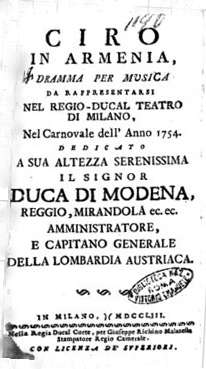Ciro in Armenia

Ciro in Armenia is a dramma per musica or opera in three acts by composer Maria Teresa Agnesi Pinottini.[1] The work premiered in Milan on 26 December 1753 at the Teatro Regio Ducal.[2][3] The work uses an Italian language libretto by the composer which is based on a work by Umberto Manferrari and G. Manfredi.[1]
Background
Pinottini was one of the earliest female Italian opera composers, and this opera was considered her finest achievement.[4] Pinottini had previously composed two other operas; the first of which, II Restauro di Arcadia, also premiered at the Teatro Regio Ducal in 1747.[5]
A complete score of Ciro in Armenia was lost during World War II.[1] Only fragments from the opera survive, some of which have been recorded.[6] The surviving portions of the score are a part of the collection of the library at the Milan Conservatory.[7] Tom Service, music critic for The Guardian, included the work is his 2015 list of the 10 best operas written by women composers.[6]
Roles
The information in this section is taken from the published libretto (see 'External links').
| Role | Voice type | Premiere cast, 26 December 1753 |
|---|---|---|
| Ciro (Cyrus the Younger of Persia) | Domenico Luino | |
| Semira, Ciro's sister | Camilla Mattei | |
| Araspe, Ciro's general | Antonio Priori | |
| Arsace, King of Armenia | Litterio Ferrari | |
| Tigrane, son of Arsace | Giovanni Tedeschi | |
| Palmide, princess of Phrygia, affianced to Tigrane. | Colomba Mattei |
Synopsis
The story is elaborated (unhistorically) from Xenophon's account in his Anabasis of Cyrus the Younger's campaign in 401 BC. The plot centres on the plans of Ciro (Cyrus) to wage war against Assyria in league with the Medes. However the King of Armenia, formerly a vassal of the Medes, changes allegiance to side with the Assyrians, prompting Cyrus to invade Armenia. Cyrus quickly overwhelms the Armenians. Tigrane, son of the Armenian King Arsace, was a childhood friend of Ciro and persuades him generously to forgive Arsace, allowing the marriage of Tigrane with the Phrygian princess Palmide.[8] [9]
References
- 1 2 3 Barbara Garvey Jackson (1994). Say Can You Deny Me: A Guide to Surviving Music by Women from the 16th Through the 18th Centuries. University of Arkansas Press. p. 9.
- ↑ Jon Paxman (2014). A Chronology of Western Classical Music 1600–2000. Music Sales Group. p. 271.
- ↑ Antonella Cupillari (2007). A Biography of Maria Gaetana Agnesi, an Eighteenth-century Woman Mathematician: With Translations of Some of Her Work from Italian Into English. Edwin Mellen Press. p. 184.
- ↑ Alfred Loewenberg (1943). Annals of opera, 1597–1940. W. Heffer & Son. p. 114.
- ↑ Sven Hansell, Robert L. Kendrick. "Maria Teresa Agnesi", Grove Music Online, ed. L. Macy (accessed January 25, 2016)
- 1 2 Tom Service (March 6, 2015). "The 10 best operas by women". The Guardian.
- ↑ "[Ciro in Armenia]". worldcat.org. Retrieved January 26, 2016.
- ↑ Libretto, pp. 7–9. See 'External links'.
- ↑ Arsaces and Tigranes were both names of a number of Armenian kings, but no rulers with these names were on the throne at the time when the story is set.
External links
Libretto in Google Books.